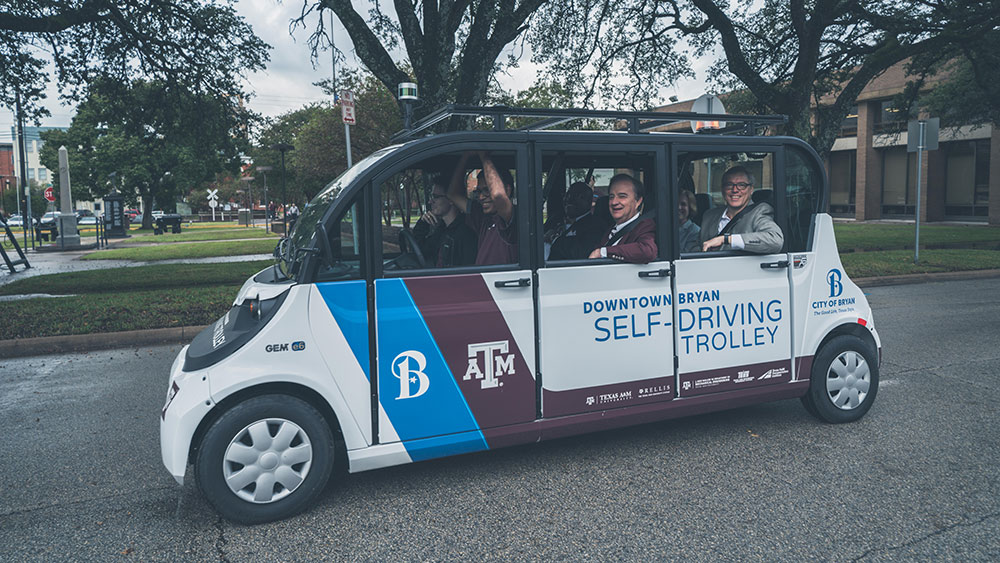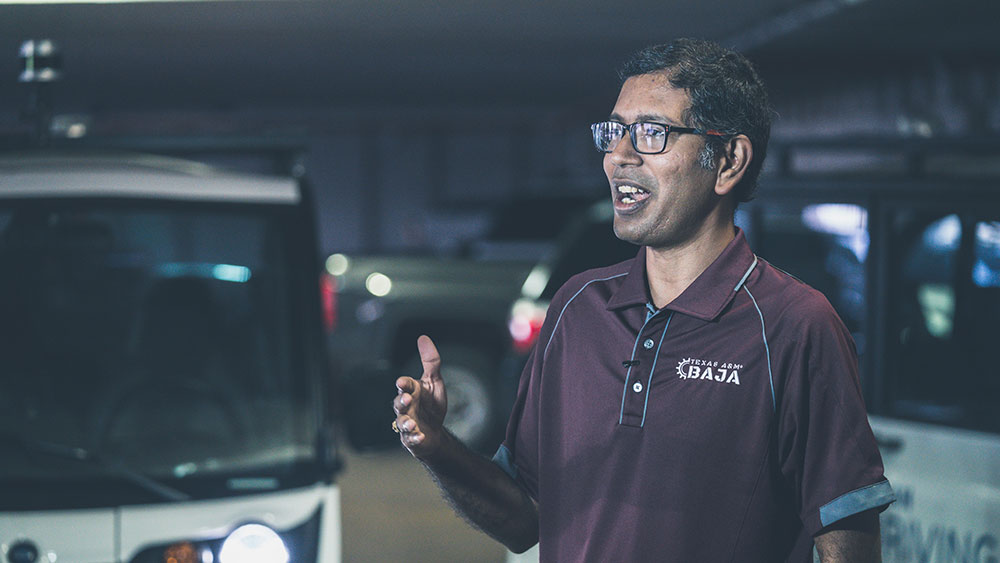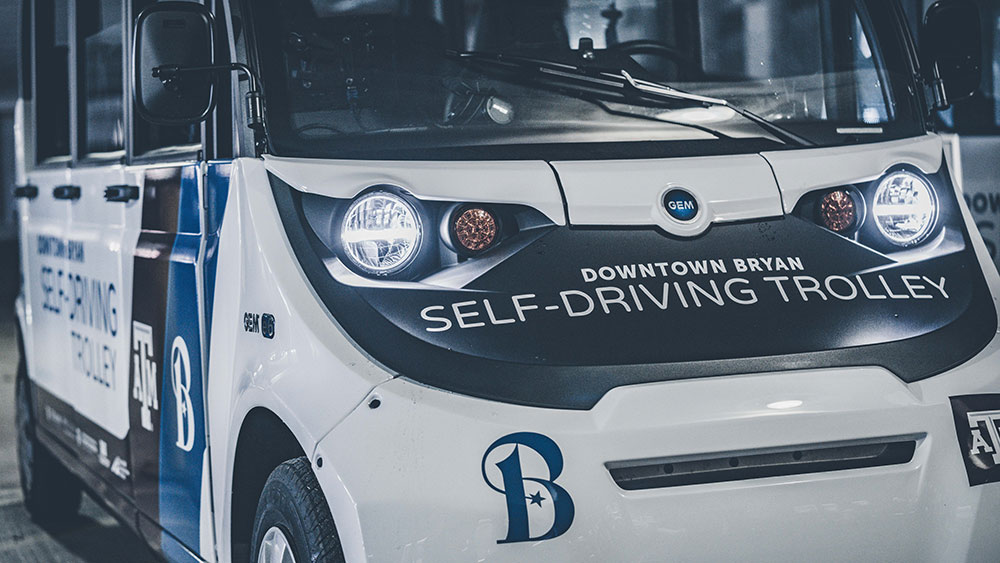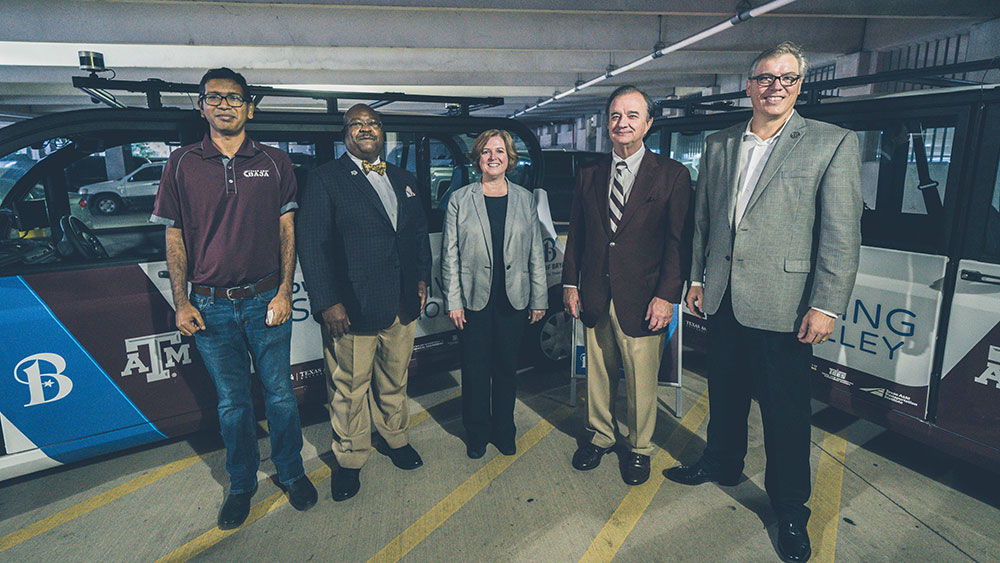
The self-driving shuttle system led by Texas A&M University researchers has officially launched in Downtown Bryan, giving the community an opportunity to experience the emerging technology in Aggieland.
Researchers said Downtown Bryan provides an ideal environment for the month-long test, which features two autonomous trolleys, thanks largely to its pedestrian-friendly layout in a relatively high-traffic area.
“The objective for these trolleys is to replace the need for some of the cars that clog up downtown,” said Dr. Srikanth Saripalli. “Downtown Bryan is perfect for this research because there are a lot of pedestrians and the city wants to make it a more walkable area. I think it’s a perfect environment for testing how these shuttles can actually work in the real world.”

The project is led by Saripalli, an associate professor in the J. Mike Walker ‘66 Department of Mechanical Engineering, and is a collaboration between the Texas A&M Engineering Experiment Station, the Texas A&M Transportation Institute, the College of Engineering and the City of Bryan.
The electric trolleys will initially run Monday through Friday in two-hour intervals between the hours of 10 a.m. and 4 p.m. on a fixed two-block route along Main Street and Regent Avenue between 26th Street and 29th Street, which is estimated to take roughly five minutes from start to finish. Designated stops will be marked by numbered A-frame signs.
Each of the autonomous vehicles will travel at a maximum of 7 to 10
Saripalli and his team will be observing several technical and social factors as the trolleys are exposed to the public in Downtown Bryan’s vehicle and pedestrian-friendly space.
Among the most important

One measurement of success for the project, Saripalli said, will be determining if the team can reduce the number of disengagements for the trolleys over the test period.
All of the data collected from the test, including the number of and reasons for vehicle disengagements, will be posted online to allow for better transparency, increased awareness and acceptance of the shuttles.
“Currently there are a few tests being run by private companies, such as the Waymo and the GM Cruise, but the data is not public and is not available to the city planners and federal or state governments,” Saripalli said. “Our data will be open and will help
From a technical standpoint, researchers will be looking to test the effectiveness of using cameras versus a 360-degree field of view laser imaging, detection and ranging (LIDAR) sensors to run the shuttle on its route. Saripalli said finding out how effective the cameras are versus the more expensive LIDAR sensors could allow for a cost-reduction for some low-speed autonomous shuttle vehicles.
The technologies, along with GPS and other equipment, will allow the trolleys to detect their surroundings and account for pedestrians, bicyclists, other vehicles and various obstacles that may impede their path.

The final factor Saripalli and his team will observe is the social acceptance of the trolleys during their run.
“We want to know how well the trolleys are going to be accepted,” Saripalli said. “Will people find it useful or will they maybe think it is a cool toy, but there is no real use for it? Those are things we want to know.”
The team will monitor social media, consider rider interactions with the student workers on the shuttle and take into account the number of rides given each day as factors of acceptance. With the potential to give 20 rides per vehicle per day, Saripalli said reaching around 30 total rides each day would be an indicator of success.
Before coming to Downtown Bryan, the trolleys have undergone several rounds of testing in increasingly populated and complex environments, including the RELLIS Campus, a route from The Stella Hotel to Traditions Club and a route on the Texas A&M campus near the Memorial Student Center.
At the end of the month-long testing period in downtown, researchers and city officials will assess the next steps and potentially explore the possibility of extending or expanding the trolley test.